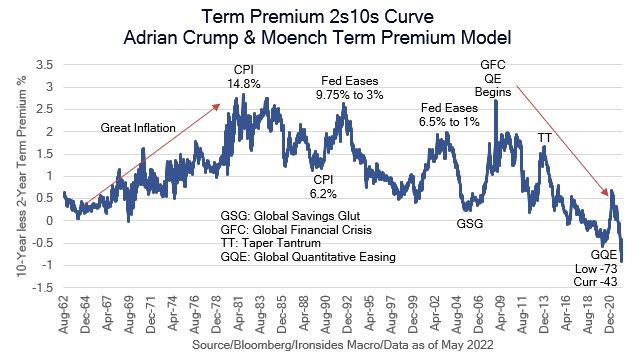Resumo do Relatório
Valuation Comeuppance
Valuation Comeuppance
QT credibility, goods, house prices and wages peaking, valuation comeuppance
 |
Quantitative Tightening Credibility
After some reflection on the whirlwind events of last week, we are most surprised, but probably shouldn’t be, by market participants’ underappreciation of the impact of quantitative tightening evident in the 23bp steepening of the 2s10s Treasury curve following the Fed meeting. When we wrote Returnless Risk two weeks ago and Relief Rally last week, we made our case that the Fed policy path was fairly priced in both the front-end of the Treasury and equities market, but that long term Treasury yields were still too low given a negative term premium and zero real rates (TIPS yields). On the day of the meeting, the balance sheet contraction plan was more tentative than we expected, however, like the reaction to the soft release of the plan in the March meeting minutes three weeks ago, long term Treasury prices plunged as investors began to seriously consider just how far those prices were from fundamental fair value due primarily to the massive Fed pandemic purchases. As much credit as Chairman Powell gets for his anti-Greenspan obfuscation communication, when he says things like “we don’t really know balance-sheet shrinkage effects”, if you consider that the pandemic response was 150bp of rate cuts and $5 trillion of balance sheet the expansion, the rate equivalent of ~250bp, their credibility is questionable at best, at least in our view. Consequently, our explanation for the quick reversal of the relief rally following the as expected policy steps and removal of 75bp rate hike optionality, was the sharp move in longer-term rates attributable to investor concerns about the implications of QT exacerbated by the Fed’s lack of confidence in the implications of balance sheet contraction. Even after the 134bp increase in 10-year real rates and 50bp increase in the 10-year term premium (see definition and link below), those rates remain well below our assessment of fundamental fair value given the longer-term outlook for inflation, growth, demand for capital and monetary policy.
On the plus side, our outlook for inflation is improving, goods prices and wages appear to have peaked and in this note we will make a case for how house prices, the source of inflation the Fed has the most control over, are also likely to slow considerably. The implications of peak inflation are that the Fed is likely to be able to slow the rate hike process in the fall. At that point QT will be the primary source of policy tightening and while we think longer term yields are headed higher, the private sector is well positioned to absorb those hikes. Additionally, as we explain later in the report, the implications for the equity market are smaller than Thursday and Friday’s price action implies. Given the 15% decline in the S&P 500, any further drop would approach the scale of the 2011 and 4Q18 Fed policy corrections, in both of those cases the markets were also absorbing significant policy shocks. In 2011, the markets had to deal with the possibility of a US sovereign default during the debt ceiling and budget showdown on Capitol Hill that led to a US ratings downgrade. In 2018, the trade war was in the early stages of triggering a global manufacturing and export recession. No such shock exists today. We expect the equity market to stabilize and recover in the coming weeks.

Aviso legal
DISCLAIMER: Este Relatório de Análise foi elaborado e distribuído pelo Analista, signatário unicamente para uso do destinatário original, de acordo com todas as exigências previstas na Resolução CVM nº 20 de 26 de fevereiro de 2021 e tem como objetivo fornecer informações que possam auxiliar o investidor a tomar sua própria decisão de investimento, não constituindo qualquer tipo de oferta ou solicitação de compra e/ou venda de qualquer produto. As decisões de investimentos e estratégias financeiras devem ser realizadas pelo próprio leitor, os Analistas, ou a OHMRESEARCH não se responsabilizam por elas. Os produtos apresentados neste relatório podem não ser adequados para todos os tipos de investidores. Antes de qualquer decisão de investimentos, os investidores deverão realizar o processo de suitability no agente de distribuição de sua confiança e confirmar se os produtos apresentados são indicados para o seu perfil de investidor. A rentabilidade de produtos financeiros pode apresentar variações e seu preço ou valor pode aumentar ou diminuir num curto espaço de tempo. Os desempenhos anteriores não são necessariamente indicativos de resultados futuros. A rentabilidade divulgada não é líquida de impostos. As informações presentes neste material são baseadas em simulações e os resultados reais poderão ser significativamente diferentes.
O(s) signatário(s) deste relatório declara(m) que as recomendações refletem única e exclusivamente suas análises e opiniões pessoais, que foram produzidas de forma totalmente independente e que a OHMRESEARCH não tem qualquer gerência sobre este conteúdo. As opiniões aqui expressas estão sujeitas a modificações sem aviso prévio em decorrência de alterações nas condições de mercado. O Analista responsável pelo conteúdo deste relatório e pelo cumprimento da Resolução CVM nº 20/21 está indicado acima, sendo que, caso constem a indicação de mais um analista no relatório, o responsável será o primeiro analista credenciado a ser mencionado no relatório. Os analistas cadastrados na OHMRESEARCH estão obrigados ao cumprimento de todas as regras previstas no Código de Conduta da APIMEC para o Analista de Valores Mobiliários e no Manual de Controles Internos para Elaboração e Publicação de Relatórios da OHMRESEARCH. De acordo com o art. 21 da Resolução CVM nº 20/21 caso o Analista esteja em situação que possa afetar a imparcialidade do relatório ou que configure ou possa configurar conflito de interesse, este fato deverá estar explicitado no campo “Conflitos de Interesse” deste relatório.
O conteúdo deste relatório é de propriedade única do Analista signatário e não pode ser copiado, reproduzido ou distribuído, no todo ou em parte, a terceiros, sem prévia e expressa autorização deste Analista. Todas as informações utilizadas neste documento foram redigidas com base em informações públicas, de fontes consideradas fidedignas. Embora tenham sido tomadas todas as medidas razoáveis para assegurar que as informações aqui contidas não são incertas ou equívocas no momento de sua publicação, o Analista não responde pela veracidade das informações do conteúdo.
Para maiores informações, pode-se ler a Resolução CVM nº 20/21 e o Código de Conduta da APIMEC para o Analista de Valores Mobiliários. Este relatório é destinado exclusivamente ao assinante da OHMRESEARCH que o contratou. A sua reprodução ou distribuição não autorizada, sob qualquer forma, no todo ou em parte, implicará em sanções cíveis e criminais cabíveis, incluindo a obrigação de reparação de todas as perdas e danos causados, nos termos da Lei nº 9.610/98 e de outras aplicáveis.





